| < Prev | Next > |
|---|
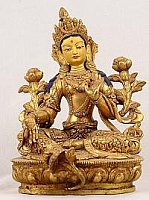 Sacred Tibetan art has always developed independently from common art, even though it also influenced achievements in sacred art. The religious connection to Indian art via tantric Buddhism is also particularly important. Along with thangkas, sacred cloth scrolls, metal sculptures are one of the most important artistic representation forms of religious matter. Small bronze or copper statues stand out as gems of Tibetan art whose filigree attests to the high craftsmanship of their creators.
Sacred Tibetan art has always developed independently from common art, even though it also influenced achievements in sacred art. The religious connection to Indian art via tantric Buddhism is also particularly important. Along with thangkas, sacred cloth scrolls, metal sculptures are one of the most important artistic representation forms of religious matter. Small bronze or copper statues stand out as gems of Tibetan art whose filigree attests to the high craftsmanship of their creators.
Origins of Tibetan Statues
As with Christian art, Buddhism in its early phases lacked visual form in art. Buddhism still refrained from the visualization of divine figures at its height around the third century BC. It was not until the first century AD that the representations of Buddha in Northern India became common. Stone and wooden sculptures and reliefs began henceforth to represent figures of Buddhism and to tell their stories. This sacred art was widely commissioned as far as the Himalayan area, especially in Nepal, where a tradition of metal handcrafts had already developed.
The high Indian art of the Gupta Period (320-475) met the emerging skills in handicrafts and brought the Nepalese art to its prime. Although initially made of wood or stone, sculptures and reliefs were then increasingly made of metal. And high quality representation forms gradually emerged during the development of the aesthetics of the Licchavi Period (300-879).
Art in Metal
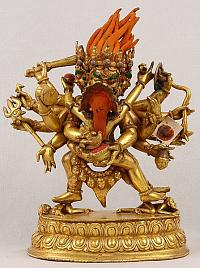 Sculptural representations of divine figures first found their place in temples. Mainly the gold-plated figurines but also partly the unpainted copper figurines spread out from Nepal into the entire Asian region, especially into the Himalayas and Tibet. This religiously informative art featured a rich iconography and also presented many religious tales.
Sculptural representations of divine figures first found their place in temples. Mainly the gold-plated figurines but also partly the unpainted copper figurines spread out from Nepal into the entire Asian region, especially into the Himalayas and Tibet. This religiously informative art featured a rich iconography and also presented many religious tales.
This art reached a high point in the temple Jokhang in Tibet. The temple was built in the 7th century for a Buddha figure that the princess Bhrkuti brought with her in her dowry from Nepal, when she married the Tibetan King Songtsen Gampo (618-649). Political instability followed, which hampered the development of this art. Progress resumed later, however, beginning in the 11th century and since then it has enjoyed increasing worldwide prestige. These early developments established a tradition of figure making that remains today.
Themes and Motifs
The Tibetan statues present exclusively gods and goddesses found in both Buddhist and Hindu traditions. They include, for example: Amitabha, the Buddha of unending light, Ganesh, the elephant-headed Hindu god of wisdom and learning, the Buddha himself or also Shiva, one of the most important Hindu gods. Their forms and attributes developed from the effectiveness of imagery that spans back millenniums.
Execution and Creation
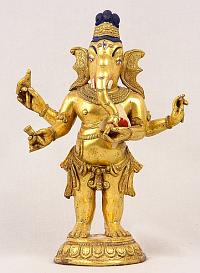 The techniques that originated from Nepal are among the complex and elaborate processes in art and span a history of more than 2,500 years. Since each casting mold can only be used once, each figurine is unique from the beginning. With the help of a traditional tool made from bones the figurine is first molded in beeswax.
The techniques that originated from Nepal are among the complex and elaborate processes in art and span a history of more than 2,500 years. Since each casting mold can only be used once, each figurine is unique from the beginning. With the help of a traditional tool made from bones the figurine is first molded in beeswax.
Next the craftsman layers it with clay and sets it in the sun for weeks to try. Then the wax is melted out and the remaining hollow space is filled with molten metal. As soon as the the metal hardens, the clay shell is shattered and the metal figure cast remains.
The cast figurine is at first rather rough. The fine details are then chiseled in the hard metal, a tedious job that can take up to one week. Next, depending on the desired appearance, the craftsmen apply many layers of polish or a finish for the top most layer. Details are then applied with enamel or the figures are decorated with semi-precious stone. Only copper figurines are normally gilded.
More Details
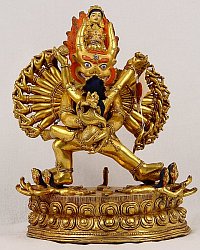 Complicated and elaborate statues like God Yamanthaka with 36 arms are cast as separate parts and are set together at the end. Often a figurine consists of several removable, single parts like the removable stand or "Shakti" in the position of embrace.
Complicated and elaborate statues like God Yamanthaka with 36 arms are cast as separate parts and are set together at the end. Often a figurine consists of several removable, single parts like the removable stand or "Shakti" in the position of embrace.
Copper is used for the best figurines. But also brass (more recent) and bronze alloys are to be found. And as long as everything is done by hand, one can assume that the degree of purity of the metals used is low.
Gold is applied only to the best and most expensive figurines. There are two methods, that were referred to in Nepal as "gold-plated" and "gold-gilded". The lesser-demanding method is "gold-gilded". The gold is applied using a mercury process. The result is a very bright gold tone that looks somehow like "fools' gold". Gold-plated on the other side produces a warm, saturated and lush gold effect. For the "gold-plated" method very thin plates of real gold are applied and melted into the metal using fire. This method is not only more elaborate, but requires also more of the precious gold metal.
Tips for Collectors of Tibetan Statues
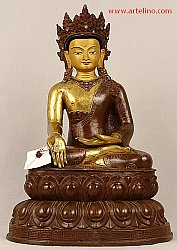 When I was in Nepal for the last time in the early 1980s, one could still watch the Newari artisans in the backyards of Patan and other places at work. The creation process of these stunning statues was as described and literally unchanged for centuries.
When I was in Nepal for the last time in the early 1980s, one could still watch the Newari artisans in the backyards of Patan and other places at work. The creation process of these stunning statues was as described and literally unchanged for centuries.
But on the market for Tibetan/Nepalese figurines distinctive changes were quite obvious. The average tourist was lured with cheap statues coming from Indian mass productions that were not created by the "lost wax" principle, but by reusable molds that could produce thousands of the same pieces.
The better pieces were offered in the numerous shops and in the hotel arcades. Within a few years from the late 1970s until the early 1980s, you could see changes in this upper market too - at a crazy speed that was comparable to today's market for mobile phones. Western tourist preferred simple motifs like the sitting Tara or the standing Buddha. Wrathful gods with 12 arms and 5 heads in embracing with their Shakti consorts were left aside. Thus it was a natural development that dealers commissioned from the Newari artisans only the kind of statues that were salable and (unfortunately) much easier to produce.
Elaborate and sophisticated figurines in top quality were hard to find in the early 1980s. One had the best chances in the vicinity of the lesser frequented sight-seeing places that only seldom saw package-tourist groups.
Also the expensive figurines have differences in quality. I recommend to look at the modeling of the hands and the feet. However for high-quality, gold-plated statues, set with semi-precious stones and painted, the differences in quality are low. As the craft has been exerted only by a small number of the same families for centuries, a high quality standard is assured for the expensive pieces.
Dieter Wanczura







